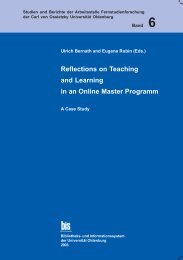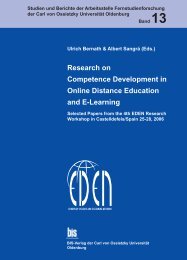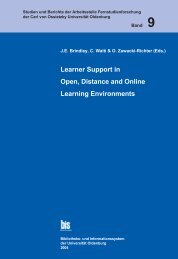Distance Education in Transition - Master of Distance Education ...
Distance Education in Transition - Master of Distance Education ...
Distance Education in Transition - Master of Distance Education ...
Create successful ePaper yourself
Turn your PDF publications into a flip-book with our unique Google optimized e-Paper software.
Visions <strong>of</strong> Autonomous Learn<strong>in</strong>g<br />
� Presentation <strong>of</strong> the problem<br />
� Learners post their first perceptions <strong>of</strong> the problem<br />
� Learners explore the problem and the first perceptions<br />
� Learners revise their first perceptions <strong>of</strong> the problem<br />
� Learners prepare and post a critical reflection record.<br />
The learners develop hypotheses and possible solutions and search for evidence to support<br />
their hypotheses. In this way it is possible for them to compare and modify solutions.<br />
7.6. Distributed Learn<strong>in</strong>g by Design<br />
Recently »design« has attracted considerable attention by <strong>in</strong>structional designers. The<br />
reason for this is a transformation <strong>of</strong> this pedagogical approach. Formerly special<br />
abilities and skills <strong>in</strong> design<strong>in</strong>g were developed with students <strong>of</strong> architecture, fashion<br />
designers, eng<strong>in</strong>eers, and developers <strong>of</strong> s<strong>of</strong>tware. But now experts f<strong>in</strong>d that the »learn<strong>in</strong>g<br />
by design approach« can also be applied <strong>in</strong> other discipl<strong>in</strong>es as it can <strong>in</strong>tensify learn<strong>in</strong>g<br />
<strong>of</strong> a more general nature as well. It is pedagogically attractive because it activates the<br />
students, encourages reflection, communication and collaboration and can become a<br />
considerable source <strong>of</strong> motivation when this particular type <strong>of</strong> learn<strong>in</strong>g-by do<strong>in</strong>g is<br />
successful. Furthermore, the task to be solved is usually an authentic one. It requires the<br />
formulation <strong>of</strong> questions and the assessment <strong>of</strong> possible solutions. The designed artefact<br />
must be repeatedly compared with the orig<strong>in</strong>al. Different levels <strong>of</strong> abstraction must be<br />
dist<strong>in</strong>guished.<br />
Design approaches <strong>of</strong> this k<strong>in</strong>d have been described by Peter Reimann and Jörg Zumbach<br />
(2001, pp. 145–152), with reference to Lahti, Seitamaa-Hakkara<strong>in</strong>en and Hakkara<strong>in</strong>en<br />
(2001), Hmelo, Holton and Kolodner (2000), Schank (1994) and by Schank, Fano, Bell<br />
and Jona (1994). Jörg Zumbach and Peter Reimann (1999) tested the method <strong>of</strong> learn<strong>in</strong>g<br />
by design by develop<strong>in</strong>g a project <strong>of</strong> “<strong>in</strong>formation design” and compared this method with<br />
a Hypertext programme and with a tutorial program <strong>in</strong> which the same contents were<br />
imparted. The result: the learn<strong>in</strong>g-by design students showed more <strong>in</strong>tr<strong>in</strong>sic motivation,<br />
more rational and better balanced argumentation and better acquisition <strong>of</strong> structural<br />
knowledge <strong>in</strong> a post-test.<br />
7.7. Learn<strong>in</strong>g <strong>in</strong> Virtual Sem<strong>in</strong>ars<br />
Like the three models referred to above, a virtual sem<strong>in</strong>ar is – a special form <strong>of</strong> community<br />
learn<strong>in</strong>g. If we compare it to a real sem<strong>in</strong>ar we become aware aga<strong>in</strong> how much the<br />
pedagogical structure is rearranged <strong>in</strong> the virtual learn<strong>in</strong>g space. The <strong>in</strong>terplay between<br />
autonomous learn<strong>in</strong>g and communicative learn<strong>in</strong>g is decidedly different. The <strong>in</strong>dividual<br />
part is much stronger as each participant rema<strong>in</strong>s an autonomous learner for long time<br />
units and is able to study all the contributions <strong>of</strong> all active participants <strong>in</strong> asynchronous<br />
sem<strong>in</strong>ars. In a way a virtual sem<strong>in</strong>ar is a cohort <strong>of</strong> autonomous learners who communicate<br />
and collaborate together <strong>in</strong> a mediated way.<br />
Teachers and learners must adapt to the different learn<strong>in</strong>g situation. (We<strong>in</strong>berger &<br />
Mandl, 2001). The teachers' role changes considerably, because they are expected not to<br />
teach the autonomous learners, but to moderate the sem<strong>in</strong>ar (Salmon, 2001). The learners<br />
have to develop <strong>in</strong>dividual strategies <strong>in</strong> order to be able<br />
231





